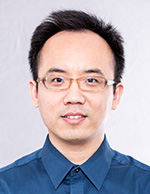光声成像向着更小型化、智能化和应用的方向发展
日期:2021/12/14 - 2021/12/14
学术讲座:光声成像向着更小型化、智能化和应用的方向发展
主讲人:Fei Gao, assistant professor in Shanghai Tech University
时间:2021年12月14日(周二)下午2:00-3:00
地点:交大密西根学院龙宾楼454会议室
腾讯会议:https://meeting.tencent.com/dm/WsakIQ6sUs0x
Code:593-129-261
讲座摘要
Combining light and sound, photoacoustic imaging is developing very fast in recent years, enabling high-resolution functional/molecular label-free biomedical imaging at centimetre’s depth. In this talk, some new advances about photoacoustic imaging towards more miniaturization, intelligence, and applications, will be introduced:
More miniaturization: As an emerging medical imaging modality, the PAI system design and optimization is of most significance. Particularly, the low-cost, miniaturization and integration of PAI system is highly desired for the wide deployment in both large hospitals and small clinics. In this talk, we will present several interesting system designs to achieve a lower cost and highly integrated PAI system. Topics include hybrid nonlinear photoacoustic imaging, low-power laser system miniaturization, PMUT PA and ultrasound imaging, few-channel data acquisition integration, flexible ultrasound transducer array design, hardware acceleration, etc.
More intelligence: It is inevitable that a lower cost and integration of PAI system will lead to sacrificed signal and image quality, such as lower signal-to-noise ratio, and limited-view image artifacts. To address these challenges, we will present several novel algorithm designs to improve signal/image quality. More importantly, we explored several novel deep learning frameworks for PA image reconstruction, quantification, classification, segmentation, etc.
More applications: Last but not least, PAI has been applied in more and more clinical applications. In this talk, we will briefly introduce several clinical applications of PAI studied in our lab, such as breast cancer screening based on adaptive ring-shape PACT, sentinel lymph node imaging based on hand-held PAI, 3D peripheral vessel imaging, skin and biopsy imaging, etc.
主讲人简介
 Dr. Gao received his bachelor degree in Microelectronics from Xi’an Jiaotong University in 2009, and PhD degree in Electrical and Electronic Engineering from Nanyang Technological University, Singapore in 2015. He worked as postdoctoral researcher in Nanyang Technological University and Stanford University in 2015-2016. He joined School of Information Science and Technology, ShanghaiTech University as an assistant professor in Jan. 2017, and established Hybrid Imaging System Laboratory (www.hislab.cn). During his PhD study, he has received Integrated circuits scholarship from Singapore government, and Chinese Government Award for Outstanding Self-financed Students Abroad (2014). His PhD thesis was selected as Springer Thesis Award 2016. In 2017, he was awarded the Shanghai Eastern Scholar Professorship. In 2018 and 2019, he received excellent research award from ShanghaiTech University. He is now the editorial board member of Photoacoustics (the flagship journal in photoacoustic imaging), and previously was guest editor of IEEE JERM, session chairs for several top conferences. He has published about 130 papers on top journals and conferences, Google scholar citation exceeds 1700. He has one paper selected as oral presentation in MICCAI2019 (53 out of 1700 submissions), and two papers selected as top papers in ISCAS2019 and BioCAS2019, which are invited to IEEE Trans. He published the first review about deep learning for photoacoustic imaging, which attracts wide attention. His interdisciplinary research topics include photoacoustic hybrid imaging physics, biomedical circuits, systems and algorithm design, as well as clinical needs driven innovation.
Dr. Gao received his bachelor degree in Microelectronics from Xi’an Jiaotong University in 2009, and PhD degree in Electrical and Electronic Engineering from Nanyang Technological University, Singapore in 2015. He worked as postdoctoral researcher in Nanyang Technological University and Stanford University in 2015-2016. He joined School of Information Science and Technology, ShanghaiTech University as an assistant professor in Jan. 2017, and established Hybrid Imaging System Laboratory (www.hislab.cn). During his PhD study, he has received Integrated circuits scholarship from Singapore government, and Chinese Government Award for Outstanding Self-financed Students Abroad (2014). His PhD thesis was selected as Springer Thesis Award 2016. In 2017, he was awarded the Shanghai Eastern Scholar Professorship. In 2018 and 2019, he received excellent research award from ShanghaiTech University. He is now the editorial board member of Photoacoustics (the flagship journal in photoacoustic imaging), and previously was guest editor of IEEE JERM, session chairs for several top conferences. He has published about 130 papers on top journals and conferences, Google scholar citation exceeds 1700. He has one paper selected as oral presentation in MICCAI2019 (53 out of 1700 submissions), and two papers selected as top papers in ISCAS2019 and BioCAS2019, which are invited to IEEE Trans. He published the first review about deep learning for photoacoustic imaging, which attracts wide attention. His interdisciplinary research topics include photoacoustic hybrid imaging physics, biomedical circuits, systems and algorithm design, as well as clinical needs driven innovation.
